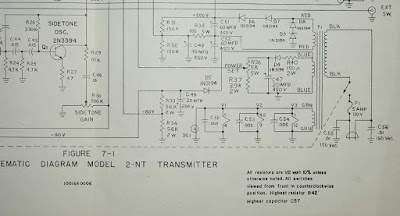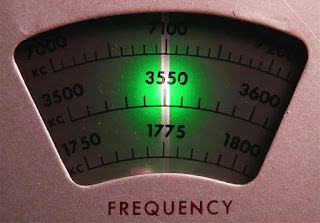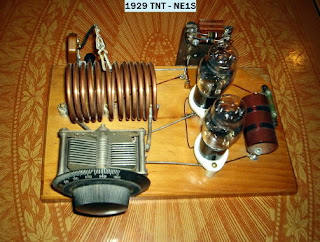Posts Tagged ‘CW’
 Hunting For NDBs In CLE 223
Hunting For NDBs In CLE 223
 |
| SN-408 courtesy: www.ve3gop.com |
This coming weekend will see another CLE challenge. This time the hunting grounds will be: 400.0 - 419.9 kHz.
For those unfamiliar with this monthly activity, a 'CLE' is a 'Co-ordinated Listening Event', as NDB DXers around the world focus their listening time on one small slice of the NDB spectrum.
A nice challenge in this one is to hear the Saint Catharines (Ontario) NDB, 'SN', on 408 kHz. 'SN' is a 15-watter and is well heard, having been logged from coast-to-coast. Look for 'SN's CW identifier, repeated every 10.5 seconds, on 408.398 kHz with your receiver in the CW mode.
Late summer CLEs can often be challenging, not because of poor propagation but more likely, lingering summer lightning storms ... hopefully it will be quiet for your location.
When tuning for NDBs, put your receiver in the CW mode and listen for the NDB's CW identifier, repeated every few seconds. Listen for U.S. NDB identifiers approximately 1 kHz higher or lower than the published transmitted frequency since these beacons are modulated with a 1020 Hz tone approximately.
For example, 'AA' in Fargo transmits on 365 kHz and its upper sideband CW identifier is tuned at 366.025 kHz while its lower sideband CW ident can be tuned at 363.946 kHz. Its USB tone is actually 1025 Hz while its LSB tone is 1054 Hz.
Often, one sideband will be much stronger than the other so if you don't hear the first one, try listening on the other sideband.
Canadian NDBs normally have an USB tone only, usually very close to 400 Hz. They also have a long dash (keydown) following the CW identifier.
All NDBs heard in North America will be listed in the RNA database (updated daily) while those heard in Europe may be found in the REU database. Beacons heard outside of these regions will be found in the RWW database.
From CLE organizer Brian Keyte, G3SIA, comes the usual 'heads-up':
Here is your Early Advice of our next Co-ordinated Listening Event.
We are back to a normal event looking for the NDBs in a narrow
frequency range - and celebrating the equinox on 22nd Sept.
All beginners, occasionals and regulars are very welcome to join in.
Days: Friday 22 Sept - Monday 25 Sept 2017
Times: Start and end at midday your LOCAL time
Range: 400 - 419.9 kHz
Just log all NDBs you can identify that are listed in the range (it includes
400 kHz but not 420 kHz) plus any UNIDs that you come across there.
We last had a close look at this frequency range in CLE208 at the
start of July 2016.
From the Ministry of Useless Information comes the advice that in CLE208
Europe listeners and Rest of the World listeners each heard 107 different
NDBs.
Please look out for the Final Details on Wednesday.
73
Brian
----------------------------------------------------------
From: Brian Keyte G3SIA ndbcle'at'gmail.com
Location: Surrey, SE England (CLE coordinator)
----------------------------------------------------------
- determine, worldwide, which beacons are actually in service and on-the-air so the online database can be kept up-to-date
- determine, worldwide, which beacons are out-of-service or have gone silent since the last CLE covering this range
- will indicate the state of propagation conditions at the various participant locations
- will give you an indication of how well your LF/MF receiving system is working
- give participants a fun yet challenging activity to keep their listening skills honed
Final details can be found at the NDB List website, and worldwide results, for every participant, will be posted there a few days after the event. If you are a member of the ndblist Group, results will also be e-mailed and posted there.
The very active Yahoo ndblist Group is a great place to learn more about the 'Art of NDB DXing' or to meet other listeners in your region. There is a lot of good information available there and new members are always very welcome. As well, you can follow the results of other CLE participants from night to night as propagation is always an active topic of discussion.
If you are contemplating getting started on 630m, listening for NDBs is an excellent way to test out your receive capabilities as there are several NDBs located near this part of the spectrum.
You need not be an ndblist member to participate in the CLEs and all reports, no matter how small, are of much value to the organizers.
'First-time' logs are always VERY welcome!
Reports may be sent to the ndblist or e-mailed to either myself or CLE co-ordinator, Brian Keyte (G3SIA), whose address appears above.
Please ... give the CLE a try ... then let us know what NDB's can be heard from your location! Your report can then be added to the worldwide database to help keep it up-to-date.
Have fun and good hunting!
 FCC Opens 630/2200 Meters Amateur Band; Pre-Registration Required!
FCC Opens 630/2200 Meters Amateur Band; Pre-Registration Required!

Yes, the headlines read, “FCC OPENS 630/2200 METERS TO AMATEUR USE AS OF OCTOBER 16, 2017; PRE-REGISTRATION REQUIRED.”
The FCC has authorized amateur radio use of the 630 and 2200-meter bands, effective October 16, 2017, providing registration procedures have been followed and no objections are received within 30 days.
The PLC (Power Line Communications) database is live and hams may begin registering immediately. They may begin operating on 472 kHz (630 meters) and 137 kHz (2200 meters) as early as October 16 if they register today and receive no objection in the next 30 days. Hams may not operate on the bands without going through this process.
Please fill out the UPC Form, today, to register your station, even if you don’t have any plans on transmitting on these new bands.
It is imperative that all amateurs register, even if they don’t plan to use these bands in the near future, as the FCC rules prohibit UTC (the Utilities Technology Council) from deploying PLC in these bands closer than one (1) kilometer from registered stations. Registration now will protect your ability to use our new MF/LF bands in the future.
 Drake 2NT And The Novice Rig Roundup (NRR)
Drake 2NT And The Novice Rig Roundup (NRR)

One of this summer's radio workbench projects was to refurbish my Drake 2NT transmitter for this winter's NRR event. The 2NT was introduced in 1966 with the 'novice' ticket-holder in mind, selling for $129. It was the first and only CW-only transmitter produced by R.L. Drake.
As novice transmitters go, the 2NT was a cut above some of the others out there, boasting interesting features such as a built-in antenna changeover relay, sidetone oscillator, grid-block keying and built-in low pass filter.
The tune-up procedure was simplified as well and with Drake's reputation for quality construction, the 2NT became a popular choice for Novices and Generals alike.
My own 2NT was purchased, along with the matching 2C receiver and speaker/Q-multiplier combo over 25 years ago at a Washington state ham fleamarket. Ever since then they have been patiently sitting on the shelf, trying to catch my attention.
The motivation and much-deserved attention finally arrived this year after enjoying last winter's NRR and hearing several great-sounding 2NT's on 80, 40 and 15m CW. I operated the week-long Roundup with my homebrew 'Longfeller' at 5W output, in order to qualify for the QRP category.
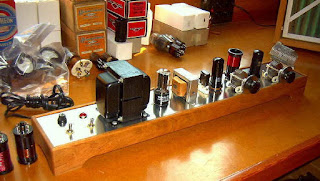 |
| 6AG7 - 6V6 'Longfeller' |
I eventually ended up with 68 contacts, but at 5W, it was a challenge ... most of my many 'CQ NRR' offerings were unanswered, so it was mostly a 'search and pounce' operation. With this in mind, I soon decided that next time, I'll get the 2NT ready to go and hopefully, with a little more oomph, can attract some callers.
 |
| Each entrant received an NRR certificate - a nice touch |
Rather than hunt down and purchase the individual replacement electrolytics, especially the multi-unit can capacitor which was impossible to source, I ordered the '2NT re-cap kit' from Hayseed Electronics. They supply replacement kits for several boatanchors and are able to make and stuff multi-section can capacitors to match the original size and specs ... and all at affordable prices.
After cleaning the chassis and all of the switches, re-tubing with new tubes and removing / replacing all of the electrolytics, the 2NT was ready to go. Using a crystal for excitation, the following results were obtained:
80m 103W input 75W output efficiency = 73%
40m 92W input 65W output efficiency = 71%
20m 92W input 65W output efficiency = 71%
15m 92W input 55W output efficiency = 58%
10m 92W input 50W output efficiency = 54%
Keydown voltages averaged ~520V while plate current ranged from 170-200ma. All-in-all, right on target and not bad for a 51 year old transmitter!
The 6EA8 modified Pierce oscillator in the 2NT seems particularly 'crystal-friendly', as every old style FT-243 style crystal that I tried sounded great. Even the newer ones from AF4K using a modern HC-49 crystal slab mounted inside a vintage FT-243 holder sounded great and worked perfectly.
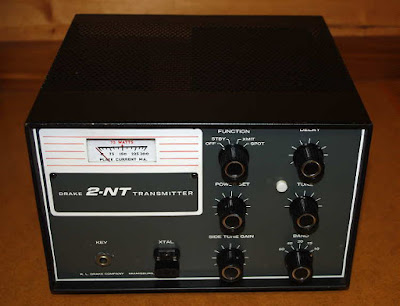 |
| My newly refurbished 2NT - ready to go |
A couple of days later, I returned to the bench to take some blog photos of the rig delivering power into the wattmeter. When I turned the 'stby' switch to 'transmit', the plate current suddenly shot up (with no keying) and the meter on my Variac supply indicated over an amp being drawn by the power transformer ... all with zero output and no crystal plugged-in!
A look at the schematic diagram revealed that with the grid-block keying system, the final amplifier's cathode is always grounded and a low voltage negative bias applied to the grid keeps the plate current cut-off until being keyed ... with cut-off bias missing, plate current will soar, along with transformer primary current. I suspected that something had gone haywire with the bias supply.
A quick check of the 2NT's printed circuit board containing the bias system components among others, indicated a discolored silicon rectifier (D5) in the bias supply. An in-circuit measurement revealed that it was indeed shorted, basically supplying raw AC across the filter capacitor and shorting out the transformer winding, quickly elevating the transformer's temperature in the bargain ... not good.
Although the diode only has to handle a small amount of current, it was mounted with a heat-producing 2W resistor straddling its top surface. As well, the phenolic circuit board was noticeably discoloured from the heat. I suspect this was the main reason that D5 eventually failed.
My 2NT was an early one, serial #670, so perhaps this parts-arrangement was re-engineered in later models. Once the diode was replaced with a much smaller modern one, of twice the rating, everything returned to normal. The last thing I would want to do at this stage is to burn out the transmitter's unique power transformer, undoubtedly impossible to replace nowadays.
The next bench project will be to refurbish and improve the stability of my Heathkit VF-1 VFO and to mate it with the 2NT.
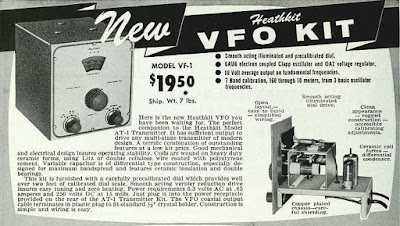 |
| '55 QST VF-1 ad |
Another small quirk noticed on my 2NT is the meter mount. My early model has the meter mounted so low that the silk-screened 'PLATE CURRENT MA.' label is not clearly visible when looking straight-on.
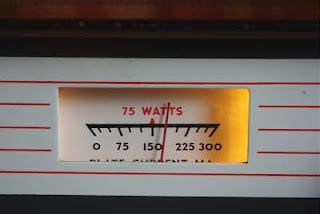 |
| My #670 |
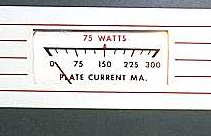 |
| Later models |
You can read many interesting soapbox comments and see some nice NRR station photos from the previous two events here and here, but read with caution as you could easily get hooked. I find pages like this very inspiring and they remind me of the days when QST would publish photos, soapbox comments and exacting equipment descriptions used by each section winner in the annual November Sweepstakes contest.
 |
| Winner's gear in '55 CW SS - remember these? |
 VE7CNF / 630m Mobile … almost.
VE7CNF / 630m Mobile … almost.
| If you think 160m mobile is a challenge... |
Hot on the heels of his recent 630m maritime adventure, Toby (VE7CNF), continued to demonstrate the flexibility of his small 20W 630m portable system with an afternoon of fixed 'mobile' activity from his vehicle.
Local 630m op's in-boxes received a surprise alert on Tuesday:
"Are any of you available on Tuedsay for a 630m land mobile test with VE7CNF/7?"
Toby set things up at Sea Island's Iona Regional Park, situated on the ocean's edge just north of Vancouver International Airport. This gave him a good shot to several of the local 630m ops around the local region.
When Canadian amateurs first approached RAC and Industry Canada for a slice of spectrum near 500KHz, the main goal was to secure a frequency range that would support excellent groundwave propagation for a possible future emergency data network. Whether this will ever happen or not remains to be seen, but Toby's afternoon outing, along with the recent 630 marine mobile activity certainly helps to demonstrate the potential for the band to provide reliable signals with relatively small antennas and low erp.
Toby's basic transverter is rather unique in that the transmitter's FET power mixer also passes signals backwards to function in the receive mode:
"I’ve developed a 630m band linear transverter that produces 30W of transmitter power. It has no power amplifier and draws only 175 mA from a 12V power supply. It works for both transmit and receive with no T/R antenna relays or switching circuits.
I’ve used a bidirectional high-power mixer circuit to directly take 100W of power from a 160m band transceiver and produce useful output power on 630m. For receive, 630m signals can pass backwards through the circuit and are up-converted to 160m.
My transverter is actually the small box on the dash above the steering wheel. The gear in the back near the variometer is used only during setup to resonate the antenna. It's a signal generator and oscilloscope. The AC transformers are just an isolation transformer that I need to make the test equipment work with my 12V-to-AC inverter."
| Toby VE7CNF/7 at Iona |
On 475.0 kHz CW I managed to work Roger VE7VV (CN88il, him 529, me 579) and Jack VA7JX (CN79kv, him 569, me 579). I heard Steve VE7SL (CN88iu) at 599 briefly, then he had a problem and we didn't complete a QSO. He gave me 599 later by email.
The antenna is about 24 ft high and the fishing-rod-and-wire top load is pulled forward about 8 ft. The matching circuit is a loading coil, variometer, and autotransformer. My Tx power was 20W TPO and estimated EIRP 75 mW. The rig was my home brew transverter with an IC-7410."
"After CW I ran WSPR for a while, 23:42 to 00:08 UTC (4:42 to 5:08 pm local). WSPRnet lists my spots as my home QTH CN89ng, but I did have CN89jf entered in WSJT-X. I got spots from WI2XJQ -17, VE7BDQ +14, VE7AB +6, VE7VV +1, W7IUV -26, WH2XGP -30 dB. I also decoded WSPR from VE7VV +7 and VA7JX +9 dB."
Our 'new' band continues to demonstrate its ability to offer exciting opportunities to experimenters, home-brewers and DXers alike and for those with the creative imagination to push new boundaries, who knows where one of the first frequency ranges to be used by amateurs back in the 20's might eventually take us.
I can visualize, at some point in the future, the usefulness of a province-wide 630m emergency comms network utilizing a basic 'grab and go' system based on much of Toby's demonstrated work.
If you are a Canadian amateur why not join the fun on 630m now? U.S. amateurs will be arriving shortly and when they do, things should be getting even more exciting on the new band!
 ETH084 – Hurricane Harvey, Solar Eclipse, HamJam 2017 and More…
ETH084 – Hurricane Harvey, Solar Eclipse, HamJam 2017 and More…
In this episode, I am joined by Ian Kahn, KM4IK, as a guest co-host. Ian has been on my podcast before in episode 69 where we talked about PSK31 and in episode 74 where we talked about Field Day. I have really enjoyed having Ian on my show and was happy that he agreed to join me in this episode as a guest co-host.
We had a great conversation about many major things that have happened recently.
We start off talking about the major event hitting my home state of Texas and reeking major damage all along the Gulf Coast. Yea, I’m talking about Hurricane Harvey. I have several friends that are helping out right now down in the disaster area and more planning on deploying there soon.
We continue our discussion with last weeks major event, the “Great American Solar Eclipse”. We talk about our experience was, some things that we saw and was other hams around the country were doing, including the study that was performed by HamSci.
We went on to talk about how it never seems to fail how things always “come back into style”. Morse code is coming back to the Navy, HF is being taught to the national guard to use instead of relying totally on Satellite Phone communications and also how there is a push to get back into using Earth base navigation for ships at least as a back up to GPS.
We wrap up the episode by talking about HamJam 2017 in November. HamJam is a ham radio conference with three great speakers talking about three great topics. There are several really awesome raffle items.
 Building For The BK Party?
Building For The BK Party?

It's almost that time of the year when, once again, the '29ers start preparing for the winter Bruce Kelley 1929 CW Party. A recent posting on the Yahoo AWA (Builder's) Group by Lou, VE3AWA, reminded everyone that there were only 108 more sleeps before this year's Party.
In case you're not familiar with the 'BK', it's a winter CW event celebrating the early days of amateur radio.
Transmitters used for the event must be self-excited only ... no crystals are allowed ... and the tube(s) used must be those that were available in 1929 or earlier. It's an eye-opener to hear how the band must have sounded in the early days of amateur radio CW... even better if you're making those beautiful sounds yourself.
The 'BK' usually spawns a flurry of construction, so if you think it is something that might interest you, you have until December to get ready! Unfortunately many aspiring '29ers always leave it too late and inevitably run out of time before any last glitches can be overcome.
For many builders of '29-style gear, especially transmitters, the two-weekend December event is the highlight of the year as it gives them the opportunity to get on the air with their early-style rigs and work as many other '29ers as they can.
Every year there are numerous transcontinental CW contacts made with the simple, usually single-tube, self-excited oscillators that look as if they would have difficulty just being heard across town! Tuning in to the BK Party may be the closest thing you can find to a 'time machine' these days, as a small section of the CW bands (160-40m) take on the same sounds you would have heard when tuning across these bands in the late '20s.
When I first listened to a BK Party several years ago, I was surprised at the wide range of signal quality coming from these faithfully reproduced exhalers, running the gamut from the 'almost Collins-like' MOPAs to the unique sounding raw-AC notes coming from some of the one-lungers.
Most of the stations I have worked in past BK events were running less than 10W input yet, even with the terrible conditions experienced in the last two events, their signals were making it across the continent on the low bands ... and all were having a great time doing it!
Larry's (NE1S) TNT makes it back to the west coast every year in the BK Party.
Shown above is a fine little TNT built by Kevin, WB2QMY, in New York. It uses a very affordable UX-201A triode, originally manufactured in 1925 for radio receivers. Although Kevin's TNT puts out barely 2 watts on 80m CW, we had no trouble working each other in the BK QSO Party. If you build it, they will come!
If you've ever entertained thoughts of wanting to participate in the '29 QSO Party, this late-summer 'heads-up', could be just what you need to make it happen ... there is still plenty of time to put something together for this year's event. Here is the specific information for this year's BK Party.
There is plenty of information available right here on my blog that will answer many of your initial concerns surrounding tubes, circuits and components:
An Introduction To Building ... '29-Style
'29-Style Transmitters ... What To Build? - Part 1
'29-Style Transmitters ... What To Build? - Part 2
As well, my own website contains several detailed construction procedures on various transmitter styles used back in the day ... and an inspirational 'Gallery of '29-Style Transmitters' from other builders. In addition, there is a lot more '29-specific information in this blog, all of which can be found here, for several nights of bedtime reading!
Should you decide to take on a simple transmitter for this year's party (and there are dozens of participants hoping that you will), here are a few things to keep in mind:
You don't need much power to make contacts ... just a few watts will do it. If your antenna system is efficient and you can hear reasonably well, expect to work '29ers all across the continent.
Your transmitter does not have to 'look pretty'! You can breadboard up something with modern components and as long as the tube-year qualifies, you're good to go. Too many get bogged-down with making a showpiece ... that can always come later.
I, and others, have found Hartley oscillators to be the easiest to get going and often produce the best notes. Although the power limit this year has been increased to 25 watts DC input, just 2 or 3 watts coming from a simple Hartley will guarantee you a ticket on the BK time machine.
A wonderful source of advice, inspiration and even help with parts, can be had by joining the AWA (Builders) Group.
For now, I'll tempt you with the basic information regarding the QSO Party as published by the 'BK' sponsor...the AWA.
The Bruce Kelly 1929 QSO Party is a yearly AWA sponsored event where participants build their own transmitters using the designs, techniques, and tubes that were available in 1929 and earlier, and then put those classic transmitters on the air and try to contact as many other 1929 stations as possible. Since they use early designs, it is a cacophony of whooping, chirping, buzzing, clicking, drifting, swishing, swaying, warbling, and other interesting signals. This is what ham radio sounded like in 1929 and for two weekends in December its 1929 again on the ham bands.
Input Power: Transmitters are limited to a power INPUT of 25 watts or less.
Frequencies: The QSO Party typically operates between 1800 to 1810 Kcs, 3550 to 3580 Kcs , 7100 to 7125 Kcs, plus or minus depending on QRM. 40 meter activity is up significantly because it offers both night time AND daytime propagation!
Presently, a large percentage of the activity is from Minnesota and points eastward ... the west is poorly represented for some reason but activity out this way has been slowly increasing over the past few years.
You don't need much in the way of power ... every year I work several eastern 'BK' stations that are running just 2 or 3 watts, usually using receiver tubes pressed into RF oscillator service ... much like the original 'boys of '29' probably had to do.
With the solar cycle winding-down and the expected return of undisturbed great winter conditions, this year's BK Party should be better than ever ... especially with even more new clunkers chirping away in the night.
Should you join the fun, there will be many '29ers looking for you I can guarantee!
 |
| courtesy:VE3AWA |
 Building For The BK Party?
Building For The BK Party?

It's almost that time of the year when, once again, the '29ers start preparing for the winter Bruce Kelley 1929 CW Party. A recent posting on the Yahoo AWA (Builder's) Group by Lou, VE3AWA, reminded everyone that there were only 108 more sleeps before this year's Party.
In case you're not familiar with the 'BK', it's a winter CW event celebrating the early days of amateur radio.
Transmitters used for the event must be self-excited only ... no crystals are allowed ... and the tube(s) used must be those that were available in 1929 or earlier. It's an eye-opener to hear how the band must have sounded in the early days of amateur radio CW... even better if you're making those beautiful sounds yourself.
The 'BK' usually spawns a flurry of construction, so if you think it is something that might interest you, you have until December to get ready! Unfortunately many aspiring '29ers always leave it too late and inevitably run out of time before any last glitches can be overcome.
For many builders of '29-style gear, especially transmitters, the two-weekend December event is the highlight of the year as it gives them the opportunity to get on the air with their early-style rigs and work as many other '29ers as they can.
Every year there are numerous transcontinental CW contacts made with the simple, usually single-tube, self-excited oscillators that look as if they would have difficulty just being heard across town! Tuning in to the BK Party may be the closest thing you can find to a 'time machine' these days, as a small section of the CW bands (160-40m) take on the same sounds you would have heard when tuning across these bands in the late '20s.
When I first listened to a BK Party several years ago, I was surprised at the wide range of signal quality coming from these faithfully reproduced exhalers, running the gamut from the 'almost Collins-like' MOPAs to the unique sounding raw-AC notes coming from some of the one-lungers.
Most of the stations I have worked in past BK events were running less than 10W input yet, even with the terrible conditions experienced in the last two events, their signals were making it across the continent on the low bands ... and all were having a great time doing it!
Larry's (NE1S) TNT makes it back to the west coast every year in the BK Party.
Shown above is a fine little TNT built by Kevin, WB2QMY, in New York. It uses a very affordable UX-201A triode, originally manufactured in 1925 for radio receivers. Although Kevin's TNT puts out barely 2 watts on 80m CW, we had no trouble working each other in the BK QSO Party. If you build it, they will come!
If you've ever entertained thoughts of wanting to participate in the '29 QSO Party, this late-summer 'heads-up', could be just what you need to make it happen ... there is still plenty of time to put something together for this year's event. Here is the specific information for this year's BK Party.
There is plenty of information available right here on my blog that will answer many of your initial concerns surrounding tubes, circuits and components:
An Introduction To Building ... '29-Style
'29-Style Transmitters ... What To Build? - Part 1
'29-Style Transmitters ... What To Build? - Part 2
As well, my own website contains several detailed construction procedures on various transmitter styles used back in the day ... and an inspirational 'Gallery of '29-Style Transmitters' from other builders. In addition, there is a lot more '29-specific information in this blog, all of which can be found here, for several nights of bedtime reading!
Should you decide to take on a simple transmitter for this year's party (and there are dozens of participants hoping that you will), here are a few things to keep in mind:
You don't need much power to make contacts ... just a few watts will do it. If your antenna system is efficient and you can hear reasonably well, expect to work '29ers all across the continent.
Your transmitter does not have to 'look pretty'! You can breadboard up something with modern components and as long as the tube-year qualifies, you're good to go. Too many get bogged-down with making a showpiece ... that can always come later.
I, and others, have found Hartley oscillators to be the easiest to get going and often produce the best notes. Although the power limit this year has been increased to 25 watts DC input, just 2 or 3 watts coming from a simple Hartley will guarantee you a ticket on the BK time machine.
A wonderful source of advice, inspiration and even help with parts, can be had by joining the AWA (Builders) Group.
For now, I'll tempt you with the basic information regarding the QSO Party as published by the 'BK' sponsor...the AWA.
The Bruce Kelly 1929 QSO Party is a yearly AWA sponsored event where participants build their own transmitters using the designs, techniques, and tubes that were available in 1929 and earlier, and then put those classic transmitters on the air and try to contact as many other 1929 stations as possible. Since they use early designs, it is a cacophony of whooping, chirping, buzzing, clicking, drifting, swishing, swaying, warbling, and other interesting signals. This is what ham radio sounded like in 1929 and for two weekends in December its 1929 again on the ham bands.
Input Power: Transmitters are limited to a power INPUT of 25 watts or less.
Frequencies: The QSO Party typically operates between 1800 to 1810 Kcs, 3550 to 3580 Kcs , 7100 to 7125 Kcs, plus or minus depending on QRM. 40 meter activity is up significantly because it offers both night time AND daytime propagation!
Presently, a large percentage of the activity is from Minnesota and points eastward ... the west is poorly represented for some reason but activity out this way has been slowly increasing over the past few years.
You don't need much in the way of power ... every year I work several eastern 'BK' stations that are running just 2 or 3 watts, usually using receiver tubes pressed into RF oscillator service ... much like the original 'boys of '29' probably had to do.
With the solar cycle winding-down and the expected return of undisturbed great winter conditions, this year's BK Party should be better than ever ... especially with even more new clunkers chirping away in the night.
Should you join the fun, there will be many '29ers looking for you I can guarantee!
 |
| courtesy:VE3AWA |

